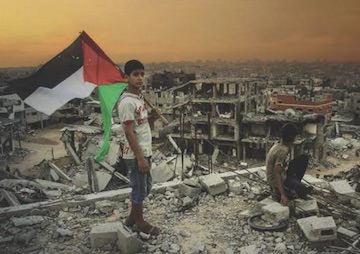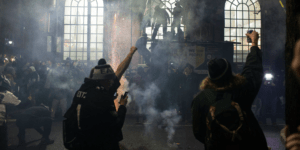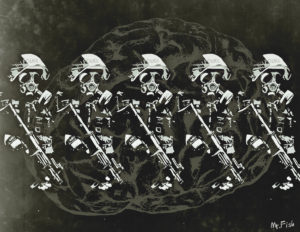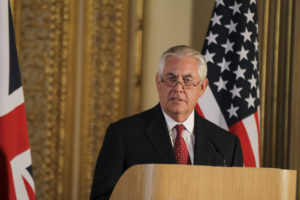How Israel Used F-16s and High-Tech Soldiers to Devastate Gaza
Forty-six days into Operation Protective Edge in the besieged Gaza Strip, the Israeli military was attacking with renewed ferocity. Nation Books
Nation Books
Editor’s note: The following is an excerpt, originally printed on AlterNet, from Max Blumenthal’s new book, “The 51 Day War: Ruin and Resistance in Gaza” (Nation Books, 2015).
46 days into Operation Protective Edge in the besieged Gaza Strip, the Israeli military was attacking with renewed ferocity. From my room in Abu Ghalion, an apartment building overlooking Gaza City’s port, with the windows shut tight and the industrial fan cranked up to maximum speed, I could still hear the roar of F-16 jets as they coasted by, and could count the seconds before they struck their target—perhaps a rocket launching site or maybe some innocent family’s home. I managed to drift off for a few hours before being ripped from my sleep by a series of explosions. It was 6 a.m. and the sun was beginning to rise over the Mediterranean.
I checked the Twitter timelines of local Gaza accounts for information on the bombings and found that most were reporting on a strike on a four-story home owned by Abu Hussein Kallab, a businessman in Rafah whose factory had been destroyed in a separate strike. Over a dozen bodies had been extracted from the rubble, including a little girl who had survived with a mouth full of concrete shards. The ferocity of the airstrike was on par with the attack aimed at Deif, a massive concentration of force on a single home that suggested top-level targets were inside.
By late morning, I learned that the dead bodies extracted from the rubble included three top Qassam Brigades commanders who had gathered inside the building to coordinate strategy. They were Raed al-Attar, the Qassam southern commander who oversaw operations in Rafah, his colleague, Mohammed Abu Shamaleh, and Mohammed Barhoum. Having led several operations in the field, including the tunnel ambush codenamed “Shattered Illusion” that brought the Israeli tank gunner Gilad Shalit into captivity, Abu Shamaleh was considered as a possible successor to Ahmad Jaabari when he was assassinated in 2012. Attar, for his part, was among Gaza’s most revered figures for masterminding of the attack that captured Shalit. The deal for Shalit’s release produced wild celebration across Palestine, but particularly in Gaza, as over a thousand prisoners were freed from Israeli jails and reunited with their families. Attar’s hero status had been secured, as had his death sentence.
For his part, Barhoum was a veteran Qassam operative who helped coordinate the transfer of weapons through the tunnel network at Rafah. The three commanders played an arguably more important role than the partially crippled Deif in the day-to-day field operations of the Qassam Brigades. Indeed, Attar had overseen the operation to capture Lt. Hadar Goldin and was rumored to be one of the few people in Gaza who knew the whereabouts of Goldin’s body.
With these assassinations, it seemed that the war would drag on endlessly. I was running low on cash and with the bombs falling again, my freedom of movement was severely compromised. That afternoon, I took a taxi to the Erez crossing and prepared to leave Gaza for a few days.
Inside the cavernous Israeli-run terminal, as I handed my passport to a young female COGAT administrator, she began pounding frantically on the bulletproof glass that separated us, ordering me to take shelter. A few seconds later, I heard something explode in the distance, likely a mortar round or rocket fired from Beit Hanoun. Watching well-protected Israeli soldiers panic was a surreal experience after witnessing the wholesale destruction they wreaked across Gaza.
In the parking lot outside Erez, an Israeli news crew from Channel 1 intercepted me and peppered me with questions about what I had seen inside Gaza. Did I see rockets fired from civilian areas? Was Hamas using human shields? What about the tunnels? Realizing this was more an interrogation session than an interview, I quickly found a taxi and headed straight to Ramallah.
That same afternoon in Rafah, 15,000 mourners marched through the streets of the war-torn southern city with the bodies of the three commanders wrapped in green Hamas burial shrouds. On sidewalks and in squares, men cried openly for the loss of those they saw as guardians of their city while colleagues of the three fallen commanders offered defiant tributes to them in a local mosque.Attar and Abu Shamaleh had survived an assassination attempt in 2003 with the help of local farmers who hid them in an olive grove while Apache helicopters hunted them down. A year later, when Israeli Special Forces raided Abu Shamaleh’s home, his neighbors helped him escape through the narrow lanes of central Rafah. This time, however, someone in the neighborhood had furnished the men’s location to Israel’s Shin Bet. Someone had been compromised by the intelligence services and induced into becoming a collaborator.
“My dad has spent his life fighting for the liberation of Palestine and today, my dad—they assassinated him,” Abu Shamaleh’s pre-teen daughter, Raba, told a local camera crew at her father’s funeral. With tears streaming down her face, the distraught girl said, “It’s all because of the collaborators and spies! And I tell my dad, God rest his soul, we’ll go after them and we’ll kill them.”
The wartime anger directed at the occupier suddenly turned towards the traitors burrowing from within. The day after Abu Shamaleh, Attar, and Barhoum’s assassination, a group of twenty-five accused collaborators that included two women was brought before a public crowd in al-Katiba Park in Gaza City. They appeared wearing masks, their identities concealed to guard their families from societal castigation. And then they were lined up against a wall and shot to death by members of the Qassam Brigades.
Photos of the execution were promptly disseminated to the media, presumably in hopes that the images would quell the anger overflowing across Gaza, and also as a warning to the collaborators who remained on the loose. Netanyahu’s office seized on the execution scenes to portray Hamas as a gang of medieval fanatics no less barbaric than ISIS. By extension, he cast himself as the leader of the Westernized outpost on the front line against what he later described as “a world-wide network of militant Islamists” that “all share this fanatic ideology; they all have not only unbridled ambitions but also savage methods.”
The image of spies dragged before firing squads is common throughout history, particularly among anti-colonial and revolutionary movements. But its appearance in Gaza exposed a depressing reality that was only discussed in whispers. Those who were executed had likely been among the most desperate of Gaza’s dispossessed population. And before they became spies, they had been spied upon by the Israeli surveillance and cyberwarfare outfit known as Unit 8200.
An intelligence corps embedded within the Israeli military, Unit 8200 consists of several thousand of the army’s most highly educated, technologically sophisticated soldiers. It is, in fact, the army’s largest unit, comparable in its size and function to the US National Security Agency (NSA). Much of Unit 8200’s work entails spying on everyone from Hezbollah and Hamas operatives to American citizens—the NSA handed over thousands of emails and phone communications to Unit 8200 of Arab and Palestinian-Americans, according to journalist James Bamford. In Gaza, Unit 8200 works with the Shin Bet to cultivate spies by compromising residents of the strip who might have fallen into difficult circumstances.
In a bracing September 12, 2014 joint letter declaring their refusal to serve any longer in the military, Unit 8200 veterans detailed how they preyed on innocent Palestinians, exploiting the weakest and blackmailing the most vulnerable. “If you’re homosexual and know someone who knows a wanted person, Israel will make your life miserable,” one of the Unit 8200 whistle-blowers explained to a reporter at the Guardian. “If you need emergency medical treatment in Israel, the West Bank or abroad—we searched for you. The state of Israel will allow you to die before we let you leave for treatment without giving information on your wanted cousin. If you interest Unit 8200 and don’t have anything to do with any hostile activity, you’re [still] an objective.”
“All Palestinians are exposed to non-stop monitoring without any legal protection,” the letter read. “Any Palestinian may be targeted and may suffer from sanctions such as the denial of permits, harassment, extortion, or even direct physical injury.” There was not a shred of sympathy to be found anywhere in Gaza for the poor souls who had fallen into circumstances that led them to collaborate. Though the Gaza-based Palestinian Center for Human Rights condemned the executions of the accused spies, a clear consensus in Gaza supported the death sentences. If I heard any dissenting opinions around Gaza, they were from those who believed the collaborators should not only have been executed, but brutalized as well.
Once again, Palestinians were pitted against one another through the machinations of their occupier. Palestinians killed Palestinians who had gotten Palestinians killed while Palestinian Authority President Mahmoud Abbas undercut the negotiating position of Hamas. Back in Tel Aviv, Netanyahu heaped praise on Shin Bet Chief Yoram Cohen for orchestrating the assassinations, while Amos Harel, military correspondent for the zealously anti-Netanyahu newspaper, Haaretz, proclaimed: “Assassinations of Hamas commanders could make Netanyahu the hero.”
But Israel was hardly finished. As the war entered its denouement in the final week of August, the military readied a series of dramatic strikes aimed at the heart of Gaza City. The goal this time was to set the stage for the war’s aftermath by provoking Gaza’s middle class against Hamas.
Reprinted with permission from Nation Books — All Rights Reserved. 2015
Max Blumenthal is a senior writer for AlterNet, and the award-winning author of Goliath and Republican Gomorrah. Find him on Twitter at @MaxBlumenthal.
Your support matters…Independent journalism is under threat and overshadowed by heavily funded mainstream media.
You can help level the playing field. Become a member.
Your tax-deductible contribution keeps us digging beneath the headlines to give you thought-provoking, investigative reporting and analysis that unearths what's really happening- without compromise.
Give today to support our courageous, independent journalists.








You need to be a supporter to comment.
There are currently no responses to this article.
Be the first to respond.